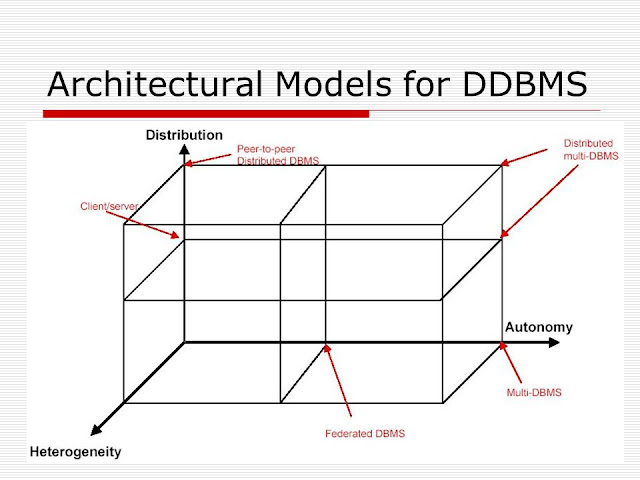Architecture Model of Distributed Database Management System (DDBMS)
Architecture Models for DDBMSs (or more generally for multiple DBMSs) canbe classified along three dimensions:- – Autonomy
- – Distribution
- – Heterogeneity
- Distribution − It states the physical distribution of data across the different sites.
- Autonomy − It indicates the distribution of control of the database system and the degree to which each constituent DBMS can operate independently.
- Heterogeneity − It refers to the uniformity or dissimilarity of the data models, system components and databases.
Architectural Models
Some of the common architectural models are
- Client - Server Architecture for DDBMS
- Peer - to - Peer Architecture for DDBMS
- Multi - DBMS Architecture
1. Client - Server Architecture for DDBMS
This is a two-level architecture where the functionality is divided into servers and clients. The server functions primarily encompass data management, query processing, optimization and transaction management. Client functions include mainly user interface. However, they have some functions like consistency checking and transaction management.The two different client - server architecture are −
- Single Server Multiple Client
- Multiple Server Multiple Client
2. Peer- to-Peer Architecture for DDBMS
In these systems, each peer acts both as a client and a server for imparting database services. The peers share their resource with other peers and co-ordinate their activities.This architecture generally has four levels of schemas −
- Global Conceptual Schema − Depicts the global logical view of data.
- Local Conceptual Schema − Depicts logical data organization at each site.
- Local Internal Schema − Depicts physical data organization at each site.
- External Schema − Depicts user view of data.
3. Multi - DBMS Architectures
This is an integrated database system formed by a collection of two or more autonomous database systems.
Multi-DBMS can be expressed through six levels of schemas −
- Multi-database View Level − Depicts multiple user views comprising of subsets of the integrated distributed database.
- Multi-database Conceptual Level − Depicts integrated multi-database that comprises of global logical multi-database structure definitions.
- Multi-database Internal Level − Depicts the data distribution across different sites and multi-database to local data mapping.
- Local database View Level − Depicts public view of local data.
- Local database Conceptual Level − Depicts local data organization at each site.
- Local database Internal Level − Depicts physical data organization at each site.
- Model with multi-database conceptual level.
- Model without multi-database conceptual level.





I have express a few of the articles on your website now, and I really like your style of blogging. I added it to my favorite’s blog site list and will be checking back soon…data science course
ReplyDeleteThank you for this informative blog. We provide what is inventory management which helps you streamline and automate your distribution network, making the process more efficient and helps you in tracking the Goods Inventory and increase visibility over the complete Supply Chain cycle right from the stage of receiving Sales Order to delivering the ordered goods and Payment Receipts.
ReplyDeleteThanks for sharing this amazing informative post with us i found this helpful for art supplies and architectural model supplies, carefully selected to inspire artists of all levels. Explore our collection at AlfaPlanhold Inc. architectural model supplies
ReplyDelete